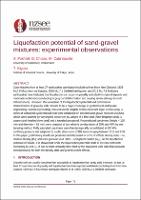Liquefaction potential of sand-gravel mixtures: experimental observations

Download
Date
2022-04-27Authors
Pokhrel, Abilash
Chiaro, Gabriele
Cubrinovski, Misko
Kiyota, Takashi
Metadata
Show full item recordAbstract
Case histories from at least 27 earthquakes worldwide (including three from New Zealand: 1929 Mw7.6 Murchison earthquake; 2010 Mw 7.1 Darfield earthquake; and 2016 Mw 7.8 Kaikoura earthquake) have indicated that liquefaction can occur in gravelly soils (both in natural deposits and manmade reclamations) inducing large ground deformation and causing severe damage to civil infrastructures. However, the evaluation of the liquefaction potential and deformation characteristics of gravelly soils remains to be a major challenge in geotechnical earthquake engineering. Aimed at providing new and useful insights on this important topic, in this study, a series of undrained cyclic triaxial tests were conducted on selected sand-gravel mixtures (SGMs), which were attained by varying the proportion by weight of a fine sand (New Brighton sand), a coarse sand (washed river sand) and a rounded pea gravel. Reconstituted specimens were prepared at two relative density states of 25% and 45% by wet tamping method. Fully saturated specimens were then isotopically consolidated at 100 kPa confining pressure and subjected to cyclic stress ratio (CSR) levels ranging between 0.15 and 0.45. In this paper, preliminary results are presented and discussed in terms of effects density state – i.e., relative density (Dr), and inter-granular void ratios – and gravel content ( ), on the liquefaction potential of SGMs. It is shown that while the liquefaction potential tends to increase with both increasing Dr and, it can be more uniquely described by the equivalent void ratio that accounts simultaneously for both the density state and gravel content effects.
